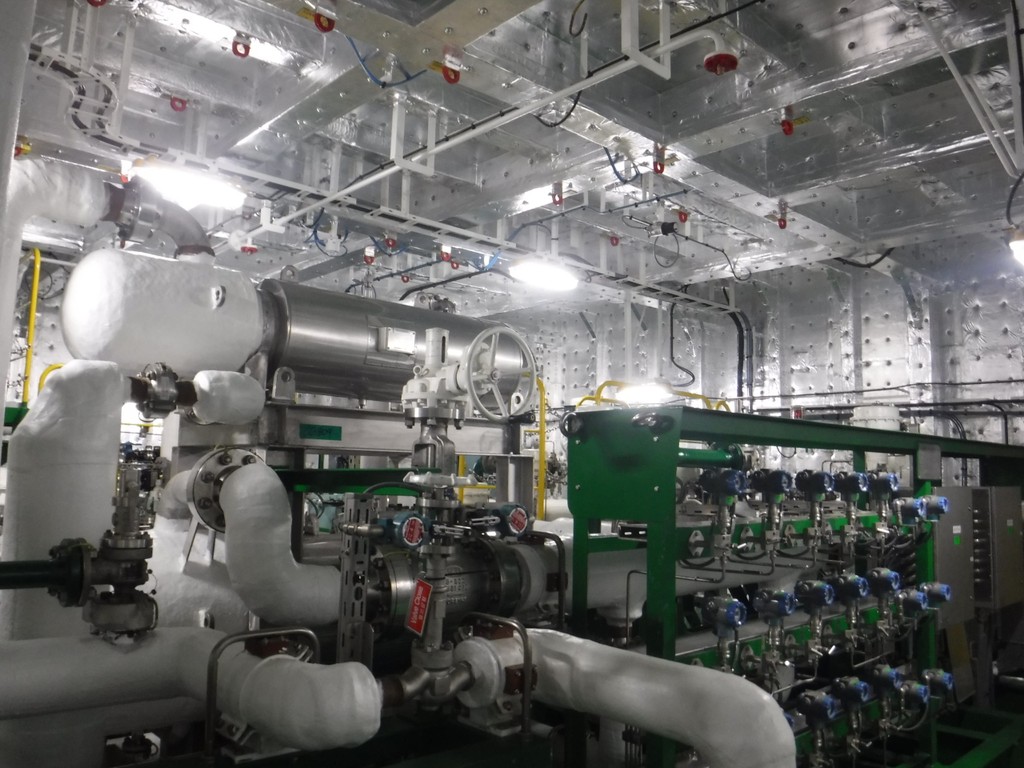The “PACIFIC EMERALD” is a dual-fuelled Aframax tanker with type-C LNG bunker tanks, as shown below, with a combined capacity of about 3,516 cubic metres. Each tank has 1 no. LNG pump which pumps the LNG to a vaporizer, where it is heated with glycol water. Resulting vaporized methane is fed in to the Main Engine, three generators and two auxiliary boilers. All these consumers can operate on dual fuel mode i.e. using either gas or fuel oil. During any long period when LNG consumption is much less – for example at anchor for more than 15 days, the bunker tank pressure can rise. To keep the tank pressure under control, there is a boil-off gas compressor in the fuel preparation room, which allows pre-heated boil-off gas to be compressed and supplied to the generators and boilers, at a pressure of about 7 bar controlled by pressure controllers.
TThe vessel has a designated fuel preparation room, as illustrated below, with all of the apparatus associated with a fuel gas supply system, including an LNG vaporizer, glycol pumps, a glycol heater, a boil-off gas compressor, and BOG preheater. There are also alarms and trips, according to all safety requirements.
The Main Engine
This is an HSD WinGD Model, 6 x 62 DF and 11,200 kW. When in gas mode, main engine operates according to the Otto cycle in that the gas admission valve is fitted just above the scavenge ports, with the gas injected into the cylinder (at between 10 and 12 bar) at the very moment that the scavenge ports are covered by the piston’s upward stroke. Together with the admission valve being fitted in the cylinder head, this means there is no need to have the familiar five stage compressor to attain around 300 bar for injecting the gas near the Top Dead Centre.
As well as three main fuel injectors, which operate only in oil mode, there are two pilot injectors. In gas mode, these pilot injectors inject the absolute minimum of LSMGO for ignition – because methane alone might not here attain its self-ignition temperature. A designated pump feeds the pilot pump forward of the Main Engine, to reach a pressure of between 800 and 1,000 bar.
The Auxiliary Engines
Three generators are all Himsen 6H22CDF, and likewise have the gas admission valve fitted on the cylinder head. The engines are four-stroke, and in gas mode, the gas is admitted into the cylinder during the combustion stroke, i.e. when the piston starts its upward travel from Bottom Dead Centre, thus requiring line pressure of only about 7 bar. Just as for the Main Engine, there is a pilot injector. There is also a main fuel injector, and a pilot pump just like the lubricating oil primer in a conventional diesel generator.
Auxiliary Boilers
The Kangrim Heavy Industries auxiliary boilers can run simultaneously in fuel and gas modes. This is especially useful during LNG bunkering, as the boilers double up as gas combustion units, just like on a conventional LNG tanker, thus managing vapour in the tanks and helping control tank pressure.
LNG bunkering
The “PACIFIC EMERALD” was the first oil tanker to bunker from Singapore’s first LNG bunker vessel, the “FUELNG BELLINA”. Unlike conventional bunkering, which is usually completed in a few hours, if it includes gassing-up and cooling down, LNG bunkering can take a couple of days.
For gassing-up, warm LNG vapour from the bunker vessel is let in, through the vapour line, to the LNG bunker tanks of the receiving vessel. The resulting piston effect displaces the inert gas from the receiving vessel’s LNG bunker tanks, and this continues until the hydrocarbon content reaches 5%. The mast vent is then shut, and the bunker and receiving vessel’s boilers, gas combustion units and generators start consuming the vapour mixture, so as to maintain the right tank pressure on the receiving vessel. Gassing-up is complete once the hydrocarbon content reaches 99%.
The next stage is cooling down the bunker tanks and lines, using cool LNG vapour. This is let in to the receiving vessel’s tanks via the top spray and liquid lines, until the lines come down to -100 deg C, which is when LNG itself can go into the tanks, though slowly and while always controlling the tank pressure, which is vital due to rapid initial evaporation causing increased pressure. Suitable control is achieved by a combination of the bunker vessel’s gas combustion unit and dual fuel generators and the receiving vessel’s boilers. The bunker tank cool-down rate is also critical, with a maximum of -10 deg C per hour.
The actual bunkering rate can be slowly increased once the tank pressures are under control. Final line draining and purging is carried out using nitrogen supplied by the bunker vessel. After purging the line, the hydrocarbon should be less than 2% in volume, and when this has been achieved, all the valves are closed and isolated.
Safety measures include high level alarms and trips in the LNG bunker tanks, and emergency shutdown will close the bunker manifold valves, thus avoiding any LNG spillage or other adverse incident.
About the author:
Mr. Sujith Sasidharan Nair is presently Assistant Technical Manager with Synergy Maritime Private Limited. He has sailing experience of over 07 years on DFDE LNG vessels as Chief Engineer/2nd Engineer and has overall sailing experience of over 16 years in companies like Maersk and Teekay. Takeover superintendent of vessel Pacific Emerald, the first ever tanker vessel to carry out STS LNG bunkering in Singapore/Asia in May 2021. Joined Synergy in 2013. Avid sportsman and a passionate cricket player.








